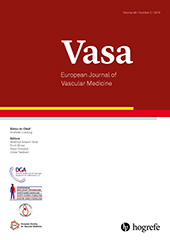Effect of metformin treatment in patients with type 2 diabetes with respect to glyoxalase 1 activity in atherosclerotic lesions
Abstract
Abstract.Background: The enzyme glyoxalase1 (GLO1) is the main opponent in the degradation of the reactive metabolite methylglyoxal (MG), which by glycation of macromolecules is involved in atherogenesis. Reduced GLO1-activity in atherosclerotic tissue is known to be associated with diabetes. It has been shown that treatment of patients with type 2 diabetes with metformin leads to increased GLO1-activity in peripheral-blood-cells. The aim of this study was to evaluate whether metformin treatment increases GLO1-activity in atherosclerotic lesions of patients with type 2 diabetes. Patients and methods: Patients with type 2 diabetes and carotid artery disease were included into the study prospectively. Type of diabetes-medication was documented upon admission along with demographic and clinical history. Using shock frozen endarterectomy-derived carotid artery plaques, GLO1-activity as well as protein expression was measured by a spectophotometric assay and western-blotting respectively. Results: 33 patients (76 % male, mean age 71 years) were included into the study and were divided according to treatment with metformin or not (15 vs. 18 patients). GLO1-activity was increased by the factor 1.36 when treated with metformin – however, not significantly (0.86 vs. 0.63 U/mg, p = 0.056). Normalisation of GLO1-activity onto GLO1-expression level lead to a significant increase by more than twofold (8.48 vs. 3.85, p = 0.044) while GLO1-protein levels did not differ significantly. GLO1-activity correlated positively with increasing HbA1c, especially under metformin treatment. Conclusions: Treatment with metformin in patients with type 2 diabetes is associated with enhanced GLO1-activity in atherosclerotic lesions. Regarding the macro- and microvascular complications in these patients further studies are needed to gain more insight into the effect of metformin on the GLO/MG system.
Literature
. Biochemistry and molecular cell biology of diabetic complications. Nature. 2001;414(6865):813–20.
Intensive blood glucose control and vascular outcomes in patients with type 2 diabetes. N Engl J Med. 2008;358(24): 2560–72.
Is diabetes an acquired disorder of reactive glucose metabolites and their intermediates? Diabetologia. 2012;55(4): 1151–5.
. Glyoxalase system in clinical diabetes mellitus and correlation with diabetic complications. Clin Sci (Lond). 1994;87(1):21–9.
. The role of methylglyoxal and the glyoxalase system in diabetes and other age-related diseases. Clin Sci (Lond). 2015;128(12):839–61.
Reduced glyoxalase 1 activity in carotid artery plaques of nondiabetic patients with increased hemoglobin A1c level. J Vasc Surg. 2016;64(4):990–4.
Glycated hemoglobin, diabetes, and cardiovascular risk in nondiabetic adults. N Engl J Med. 2010;362(9): 800–11.
. HbA1c as predictor of all-cause mortality in individuals at high risk of diabetes with normal glucose tolerance, identified by screening: a follow-up study of the Anglo-Danish-Dutch Study of Intensive Treatment in People with Screen-Detected Diabetes in Primary Care (ADDITION), Denmark. Diabetologia. 2010;53(11): 2328–33.
Effect of intensive blood-glucose control with metformin on complications in overweight patients with type 2 diabetes (UKPDS 34). UK Prospective Diabetes Study (UKPDS) Group. Lancet. 1998;352(9131):854–65.Metformin Scavenges Methylglyoxal To Form a Novel Imidazolinone Metabolite in Humans. Chem Res Toxicol. 2016; 29(2):227–34.
. Reaction of metformin with dicarbonyl compounds. Possible implication in the inhibition of advanced glycation end product formation. Biochem Pharmacol. 1999;58(11): 1765–73.
. Kinetics and mechanism of the reaction of metformin with methylglyoxal. International Congress Series. 2002;1245:355–6.
. Metformin reduces systemic methylglyoxal levels in type 2 diabetes. Diabetes. 1999;48(1):198–202.
Effect of metformin on methylglyoxal metabolism in patients with type 2 diabetes. Exp Clin Endocrinol Diabetes. 2014; 122(5):316–9.
. Accumulation of alpha-oxoaldehydes during oxidative stress: a role in cytotoxicity. Biochem Pharmacol. 1999;58(4):641–8.
Metformin protects the brain against the oxidative imbalance promoted by type 2 diabetes. Med Chem. 2008; 4(4):358–64.
. Posttranslational modification of human glyoxalase 1 indicates redox-dependent regulation. PLoS One. 2010; 5(4):e10399.
Nitric oxide inactivates glyoxalase I in cooperation with glutathione. J Biochem. 2000;128(4):647–54.
. Methylglyoxal in cells elicits a negative feedback loop entailing transglutaminase 2 and glyoxalase 1. Redox Biol. 2014;2:196–205.
Gender difference in glyoxalase 1 activity of atherosclerotic carotid artery lesions. J Vasc Surg. 2015;62(2): 471–6.
daf-16/FOXO and glod-4/glyoxalase-1 are required for the life-prolonging effect of human insulin under high glucose conditions in Caenorhabditis elegans. Diabetologia. 2015;58(2):393–401.
. Differentiation and apoptosis induction by lovastatin and gamma-tocotrienol in HL-60 cells via Ras/ERK/NF-kappaB and Ras/Akt/NF-kappaB signaling dependent down-regulation of glyoxalase 1 and HMG-CoA reductase. Cell Signal. 2015;27(11):2182–90.
Candesartan attenuates diabetic retinal vascular pathology by restoring glyoxalase-I function. Diabetes. 2010; 59 (12): 3208–15.
Effect of Irbesartan treatment on plasma and urinary markers of protein damage in patients with type 2 diabetes and microalbuminuria. Amino Acids. 2012;42(5): 1627–39.
Higher levels of advanced glycation endproducts in human carotid atherosclerotic plaques are associated with a rupture-prone phenotype. Eur Heart J. 2014; 35 (17): 1137–46.



